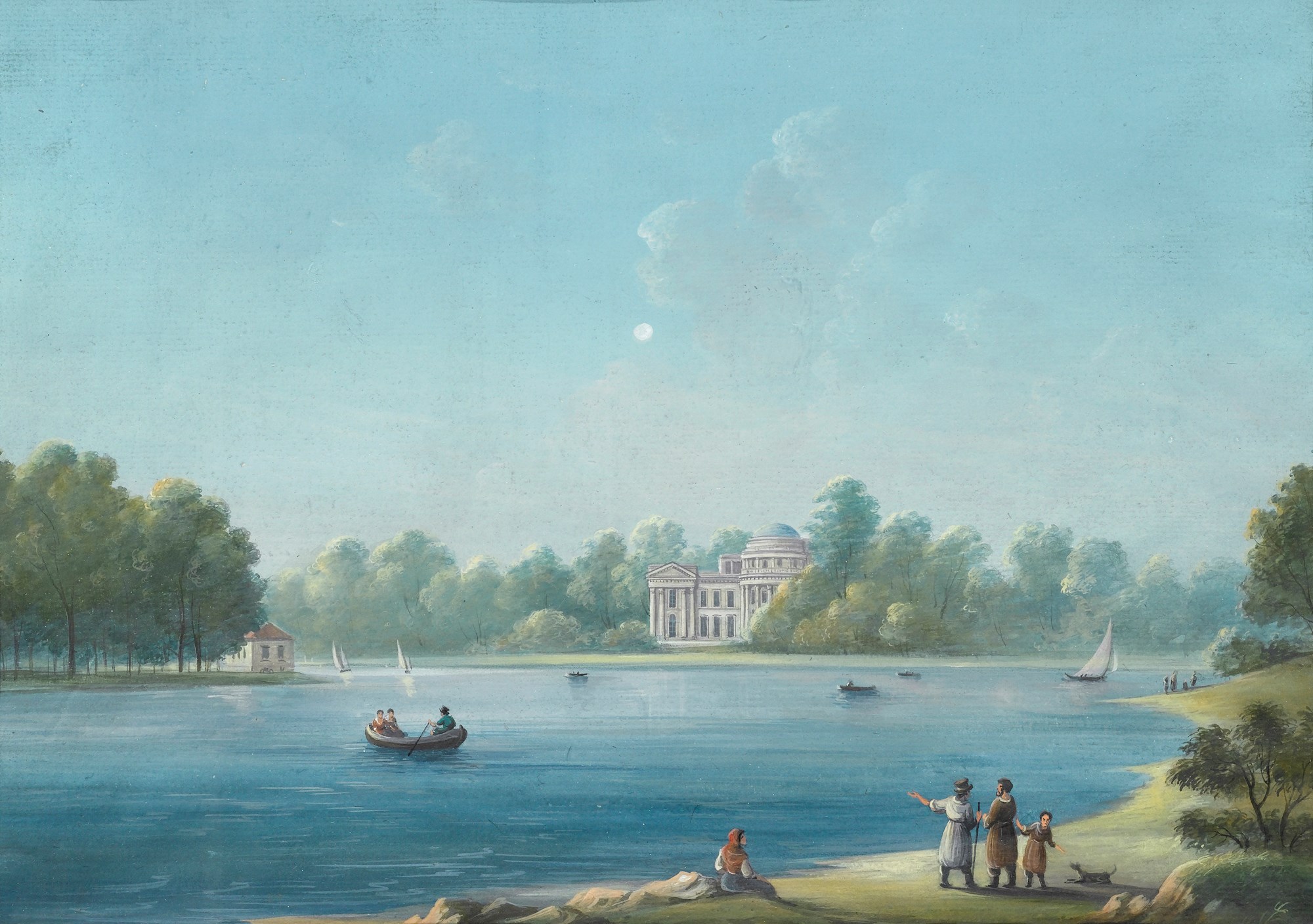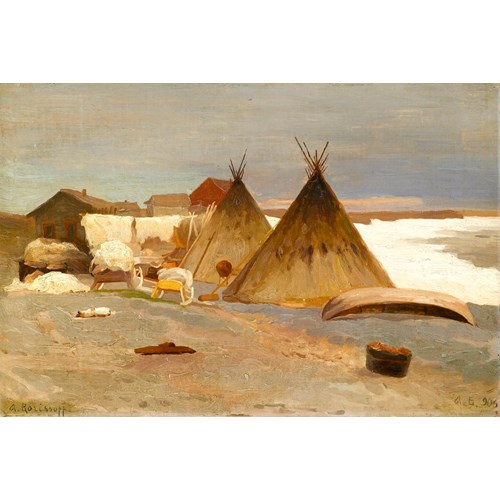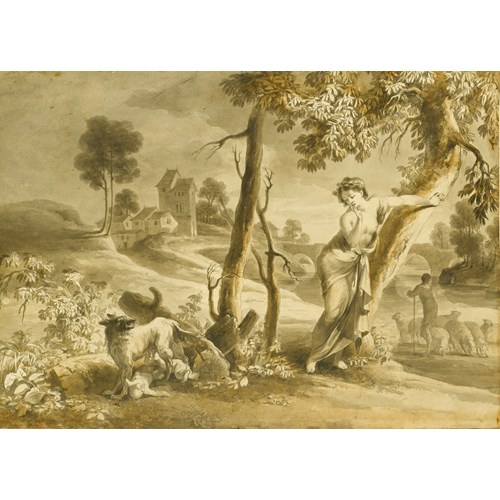Marketplace
A View of Elagin Island Palace
School Neapolitan
A View of Elagin Island Palace
Date 19th century
Period 19th century, 1750-1850, 1850-1900
Origin Italy, Naples
Medium Gouache on paper
Dimension 22.5 x 32 cm (8⁷/₈ x 12⁵/₈ inches)
A family looks out across the wide expanse of the river Neva surrounding Elagin Island, as several sail and row boats drift across its surface at a leisurely pace. Standing elegantly on Elagin Island, and in the centre of the work, is Elagin Palace. The island and palace were once the property of the nobleman Ivan Elagin (1725-1793), one of Catherine the Great’s (1729-1796) courtiers. The house was built in 1785, and was later acquired in 1817 by Alexander I (1777-1825), along with the island, for his mother Empress Maria Fyodorovna (1759-1828), who commissioned Carlo Rossi (1775-1849) to redesign it.
Facing us is the eastern façade; less formal than the main western façade, which follows a Russian neo-Classical design with a central portico supported by six Corinthian columns, the eastern façade boasts a three-storey half-rotunda, flanked by columns topped with richly ornate capitals. Its architectural fluidity and romantic setting on the banks of the Neva River, is fitting for the idyllic tone of the present watercolour.
The richness of the palette, from the steely blue water to the moss green trees, with their heightened crowns, creates a resplendent and luminous work. Through the detailed brushstrokes used to depict the surface of the water, or the spindly and delicate tree trunks, it is almost suggestive of an oil painting. A beautifully balanced and harmonious composition, A View of Elagin Island Palace, St. Petersburg embraces the landscape and beauty of the island with the same grace and importance of a Neapolitan view. It corresponds to the changes within Neapolitan school painting in the nineteenth century, which saw the residual influence of the Baroque and Caravaggio (1571-1610) being abandoned for a wider artistic movement, which embraced the landscape, and was in part romantic.
Anton Pitloo (1790-1837), a young Dutch artist who painted in rich luminous oils, was invited to Naples in 1815 by a Russian diplomat and introduced the concept of painting en plein air to the southern Italian city. Together with a group of fellow artists, including the Russian landscape artist Sylvester Feodosiyevich Shchedrin (1791-1830), he founded what is now known as the Posillipo School in c.1820. The Posillipo School, based in Naples, was solely dedicated to landscape painting. The school had its roots in the work of the landscape artist Micco Spadaro (c.1609-1675) and in the later works of Salvator Rosa (1615-1673), whilst simultaneously experimenting with influences from the wider artistic circle of John Constable (1776-1837) and J.M.W. Turner (1775-1831), whose styles reached Naples through the artists of the Grand Tour. The period also saw numerous landscapes on paper and small canvases being produced to sell to Grand Tour tourists visiting Naples, immortalising famous landscapes such as Vesuvius and Pompei. A View of Elagin Island Palace, St. Petersburg, in its small format, seems almost to be a continuation of this theme within a Russian context.
Facing us is the eastern façade; less formal than the main western façade, which follows a Russian neo-Classical design with a central portico supported by six Corinthian columns, the eastern façade boasts a three-storey half-rotunda, flanked by columns topped with richly ornate capitals. Its architectural fluidity and romantic setting on the banks of the Neva River, is fitting for the idyllic tone of the present watercolour.
The richness of the palette, from the steely blue water to the moss green trees, with their heightened crowns, creates a resplendent and luminous work. Through the detailed brushstrokes used to depict the surface of the water, or the spindly and delicate tree trunks, it is almost suggestive of an oil painting. A beautifully balanced and harmonious composition, A View of Elagin Island Palace, St. Petersburg embraces the landscape and beauty of the island with the same grace and importance of a Neapolitan view. It corresponds to the changes within Neapolitan school painting in the nineteenth century, which saw the residual influence of the Baroque and Caravaggio (1571-1610) being abandoned for a wider artistic movement, which embraced the landscape, and was in part romantic.
Anton Pitloo (1790-1837), a young Dutch artist who painted in rich luminous oils, was invited to Naples in 1815 by a Russian diplomat and introduced the concept of painting en plein air to the southern Italian city. Together with a group of fellow artists, including the Russian landscape artist Sylvester Feodosiyevich Shchedrin (1791-1830), he founded what is now known as the Posillipo School in c.1820. The Posillipo School, based in Naples, was solely dedicated to landscape painting. The school had its roots in the work of the landscape artist Micco Spadaro (c.1609-1675) and in the later works of Salvator Rosa (1615-1673), whilst simultaneously experimenting with influences from the wider artistic circle of John Constable (1776-1837) and J.M.W. Turner (1775-1831), whose styles reached Naples through the artists of the Grand Tour. The period also saw numerous landscapes on paper and small canvases being produced to sell to Grand Tour tourists visiting Naples, immortalising famous landscapes such as Vesuvius and Pompei. A View of Elagin Island Palace, St. Petersburg, in its small format, seems almost to be a continuation of this theme within a Russian context.
Date: 19th century
Epoque: 19th century, 1750-1850, 1850-1900
Origine: Italy, Naples
Medium: Gouache on paper
Dimension: 22.5 x 32 cm (8⁷/₈ x 12⁵/₈ inches)
More artworks from the Gallery




 The Harvest_T638810975891048810.jpg?width=500&height=500&mode=pad&scale=both&qlt=90&format=jpg)




